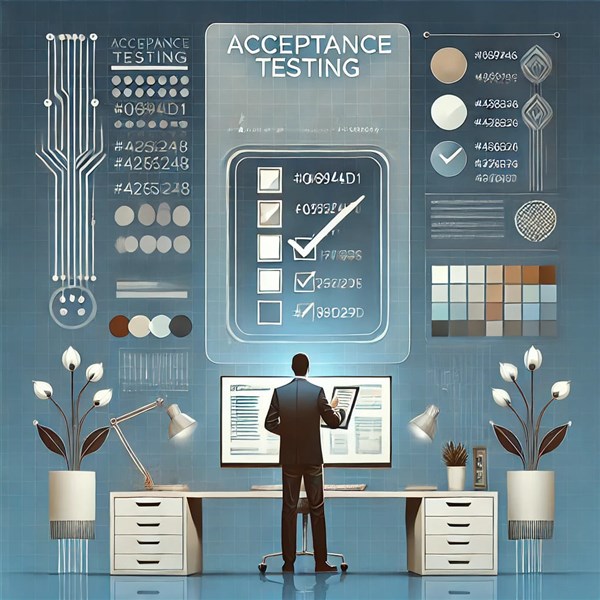We're open through the holidays to support your upskilling goals — Which training do you want to book?
We're open through the holidays to support your upskilling goals — Which training do you want to book?
Unable to find what you're searching for?
We're here to help you find it
The demand for high-quality mobile applications has never been greater. With millions of apps available on platforms like Google Play Store and Apple App Store, users expect seamless performance, intuitive UI, and bug-free experiences. However, ensuring such quality and reliability requires rigorous testing at every stage of development.
This is where Acceptance Testing plays a crucial role. It helps developers and stakeholders validate whether the mobile app meets the business requirements, user expectations, and technical specifications before release.
In this blog, we will explore how acceptance testing improves mobile app quality, its different types, best practices, and tools that help in delivering a flawless user experience.
Acceptance Testing is a final validation step in the software testing lifecycle (STLC) that determines whether a mobile application meets functional, usability, and business requirements before it goes live. It ensures that the app is ready for production and aligns with customer expectations.
Key Goals of Acceptance Testing in Mobile Apps:
✅ Verify that the app functions as intended.
✅ Identify and fix usability issues.
✅ Ensure the app meets business needs and compliance requirements.
✅ Provide a real-world simulation of how users interact with the app.
✅ Minimize post-release bugs and enhance the user experience.
Performed by: End-users, clients, or stakeholders.
Purpose: Ensures the mobile app meets real-world user expectations before deployment.
Example: Testing a banking app’s login, fund transfer, and statement download features under real-world conditions.
Performed by: Business analysts and project managers.
Purpose: Confirms the app aligns with business objectives and workflows.
Example: Checking if an e-commerce app correctly processes discount codes and orders according to business rules.
Performed by: DevOps, IT teams.
Purpose: Verifies the app’s operational readiness before deployment.
Example: Ensuring server configurations, API integrations, and network load balancing work correctly.
Performed by: Compliance teams, legal departments.
Purpose: Checks if the app meets legal, security, and industry standards.
Example: Ensuring a healthcare app follows HIPAA regulations for patient data security.
One of the biggest risks in mobile app development is encountering critical bugs after launch, leading to negative reviews, app uninstalls, and revenue loss.
✔ Acceptance testing helps detect issues before release, ensuring the app performs as expected.
✔ It provides real-world testing scenarios, identifying bugs that unit or integration tests may miss.
🔹 Example: A ride-hailing app undergoes UAT to verify GPS accuracy, ensuring users can correctly locate nearby drivers before the app goes live.
No matter how powerful an app’s features are, poor usability can drive users away.
✔ User Acceptance Testing (UAT) validates the navigation flow, design consistency, and overall ease of use.
✔ Usability tests ensure intuitive design, responsive UI elements, and touch-friendly gestures.
🔹 Example: An e-commerce app undergoes UAT where testers check if the checkout process is smooth and does not crash under load.
Mobile apps must function well under different network conditions and device specifications.
✔ Acceptance testing evaluates app performance in various environments, including low battery, slow internet, and high traffic loads.
✔ It ensures that the app works across different screen sizes, OS versions, and mobile networks.
🔹 Example: A video streaming app undergoes OAT to test buffering speed on both Wi-Fi and 4G networks.
A mobile app must align with business objectives to achieve its intended goals.
✔ Business Acceptance Testing (BAT) ensures that all features, payment gateways, and database interactions match business needs.
✔ Helps avoid misalignment between developers and business teams, reducing rework.
🔹 Example: A food delivery app undergoes BAT to check if promo codes and loyalty rewards are applied correctly at checkout.
Security is a top priority, especially for apps that handle user data, transactions, or confidential information.
✔ Compliance acceptance testing ensures the app follows GDPR, HIPAA, or PCI-DSS standards.
✔ Helps identify vulnerabilities in login security, encryption, and API access controls.
🔹 Example: A banking app is tested to confirm that multi-factor authentication (MFA) works correctly before deployment.
✅ Involve End-Users Early: Real users provide valuable feedback that developers might overlook.
✅ Create Clear Test Cases: Define real-world scenarios that simulate actual user interactions.
✅ Automate Repetitive Tests: Use Selenium, Appium, or Cucumber for test automation.
✅ Test on Multiple Devices: Validate the app on different screen sizes, OS versions, and network conditions.
✅ Document Issues and Feedback: Maintain a bug tracking system (JIRA, TestRail) to prioritize fixes before release.
|
Tool |
Purpose |
|---|---|
|
Appium |
Automating mobile UI testing (Android & iOS) |
|
TestComplete |
Functional and regression testing |
|
BrowserStack |
Cloud-based mobile app testing |
|
Selenium |
Automated web application testing |
|
Cucumber |
BDD testing for acceptance criteria |
Conclusion
Acceptance testing is critical in mobile app development, ensuring that the app meets user expectations, business requirements, and performance standards. By conducting rigorous UAT, BAT, OAT, and compliance testing, developers can reduce post-release bugs, improve usability, and enhance app stability.
With the right tools and best practices, teams can streamline acceptance testing and deliver flawless mobile applications that users love.
To effectively implement acceptance testing in your app development process, it's essential to have the right skills and knowledge. This is where Koenig Solutions comes in. As a leading IT training company, Koenig offers high-quality training courses in acceptance testing, helping you master the technique and apply it to your mobile app development process.

Aarav Goel has top education industry knowledge with 4 years of experience. Being a passionate blogger also does blogging on the technology niche.










